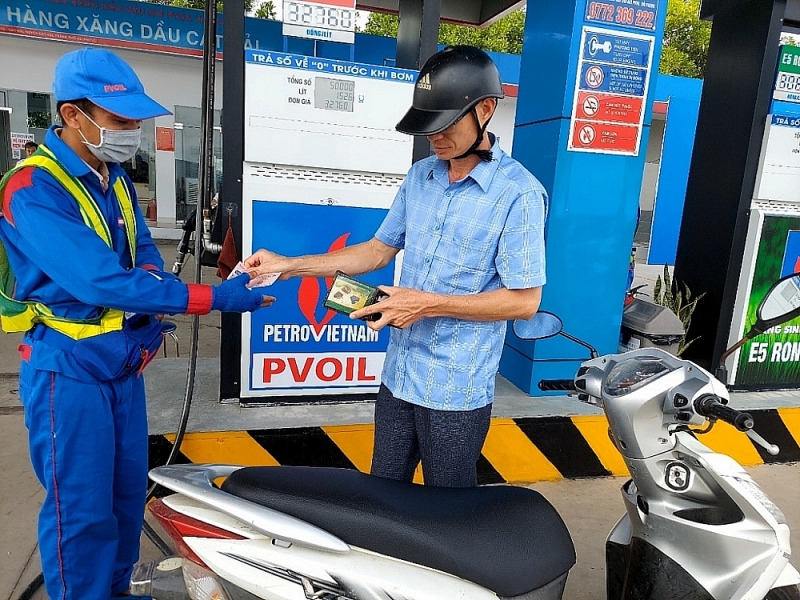 |
The setting up of provision for the price stabilization fund is made concurrently with the base price management period. Photo: Nguyễn Thanh |
Price stabilization fund not working as expected
Petroleum is a strategic commodity and is important for the production and consumption of the economy. The price stabilization fund is a tool for the State to stabilize gasoline prices when there are abnormal changes in world prices to avoid instability in people’s lives.
The price stabilization fund is established at an enterprise when it is granted a certificate of eligibility to act as a business focal point of petroleum under the provisions of Decree No. 95/2021/ND-CP. The petroleum trader, which acts as a focal point, is responsible for making provisions, spending, using, reporting and publicizing the petroleum price stabilization fund and managing this fund in accordance with the regulations. They are responsible for selecting and opening a separate monitoring account for the Petroleum Price Stabilization Fund at commercial banks or foreign bank branches lawfully operating in Vietnam (banks). They are also responsible for notifying in documents about the name, address and contact information of the bank where they open an account of the Petroleum Price Stabilization Fund to the Ministry of Finance (Department of Price Management), the Ministry of Industry and Trade (Domestic Market Department) and disclosure of information in accordance with regulations.
The price stabilization fund is established by making provisions with a specific amount of 300 VND/liter for gasoline, diesel oils and kerosene and 300 VND/kg for fuel oils at actual consumption temperatures in the domestic market and is determined as an element constituting the base price and selling price of the business focal point of petroleum trader. The setting up of provision for the price stabilization fund is made concurrently with the base price management period.
However, according to experts, the Price Stabilization Fund has not been as effective as hoped.
Faced with this fact, in the Draft Report on the Law on Price (amended), the Ministry of Finance proposed abolishing regulations on the establishment and use of the petroleum price stabilization fund.
According to the Ministry of Finance, when associated with the regulation of putting petroleum under the management of reference prices, it is possible to consider abolishing the Price Stabilization Fund to help gasoline prices follow the market mechanism. After abolishing the Price Stabilization Fund, if petrol prices rise too high or fall too low, affecting the socio-economy or in emergency cases, the authorities will implement price stabilization by following steps: check price forming factors; inventory control; examine the existing quantity and volume of goods to determine the causes as a basis for selecting appropriate price stabilization measures, deciding to apply one or several price stabilization measures as prescribed.
Careful consideration needed
Evaluating this proposal, Mr. Dau Anh Tuan, Deputy General Secretary of the Vietnam Confederation of Commerce and Industry (VCCI) said that petrol and oil should move to operate in line with the market mechanism. If management agencies can intervene to regulate and compensate for prices, they should only rely on the budget by reducing the collection of fees and taxes from petrol and oil.
“The essence of the Price Stabilization Fund is that people pay money first to stabilize themselves. When the price of gasoline increased, the fund was advanced for the price, pushing the risk to the business. When gasoline prices are high, many petroleum enterprises suffer negative funds of hundreds of billion dong. Therefore, the proposal to abolish the Price Stabilization Fund is in line with reality,” Mr. Tuan said.
According to economist Ngo Tri Long, when considering the abolishment of Price Stabilization Fund, it is necessary to consider it from many angles. Firstly, for businesses, the deduction of funds does not bring them more profits, while the spending of funds puts pressure on them. When the price of petrol increases and rise sharply as it has, there are two cases. If the fund is negative, the enterprise will “struggle” to spend the fund, even borrowing from the bank to compensate, affecting business capital. If the price of gasoline is low, the business is “suffer a bad reputation” because the price will decrease slowly due to set up a provision to compensate for the previous negative fund.
For the customer, deducting the fund is something no one wants, because the fund is actually taken from the money in their pocket. When the price of gasoline increases, the fund is deducted from the price of gasoline to stabilize the price. However, making provisions and expenditure of the fund invisibly creates a “flat scale”, because there are customers who are large enterprises and use a lot of petrol at the time of fund deduction. However, at the time of spending the fund, due to the nature of the part-time service, they do not use much fuel. Therefore, they will suffer losses and will not be interested or happy when having to deduct funds.
As for the State, the Price Stabilization Fund is a tool to control prices and inflation both directly and indirectly. It will really be an effective tool if the Petroleum Price Stabilization Fund properly performs its role, function, and mission, which is to make gasoline prices stable around a certain average level, without skyrocketing or sharp reduction. If done well, it will not cause a shock to the economy every time the market has big fluctuations, and in the long run, it will not reduce the cost of gasoline for consumers.
According to Mr. Ngo Tri Long, with the current 10-day price management method, or 15 days ago, maintaining the Price Stabilization Fund is necessary to help the State regulate gasoline prices. However, up to this point, the Ministry of Industry and Trade has proposed to shorten the petroleum operating period to 2-3 days, which means that, if letting the price fluctuate in line with the market, the maintenance of Price Stabilization Fund is not necessary.
